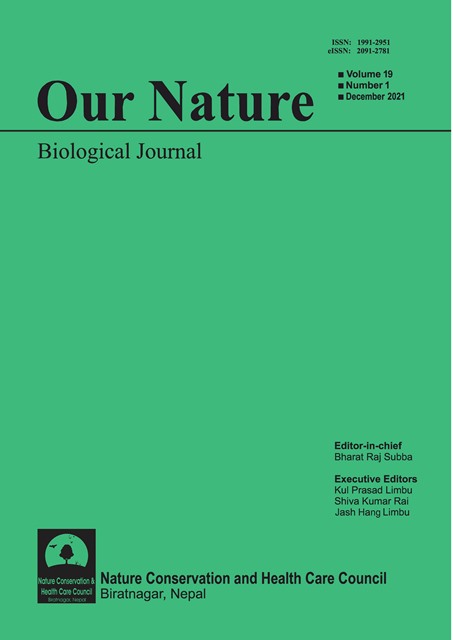A report of Siwalik forest around Letang Raja-Rani wetland, Morang, eastern Nepal
DOI:
https://doi.org/10.3126/on.v19i1.41232Keywords:
Girth class, phytosociology, Shorea robusta, soil characteristicsAbstract
Species composition, phytosociological status and soil characteristics of Siwalik forest occurring around Raja-Rani wetland, Letang municipality, eastern Nepal was studied. A total of 47 tree species belonging to 40 genera and 26 families were reported. Dominant and co-dominant trees were Shorea robusta (IVI=133.4) and Schima wallichii (IVI=70.6), respectively. In the forest total tree density, basal cover area, seedling density, fallen dead density and dead standing density were 378.4 trees ha-1, 163.7 m2 ha-1, 105250 individual ha-1, 4 trees ha-1 and 1.6 trees ha-1, respectively. Irregular girth class distribution and high stump density (136.8 tree ha-1) denote disturbance. Soil physicochemical characteristics were: acidic soil (pH 4.8), moisture (12.5%), water holding capacity (50.05%), bulk density (1.17 g cm-3), porosity (0.55%), humus (8.6%), organic carbon (0.52%), nitrogen (0.1%), phosphorus (33 kg ha-1), and potassium (300 kg ha-1). Regulating human encroachment to ensure natural regeneration of species to maintain the viability of the Letang Raja-Rani wetland site and integrity of the local ecosystem is strongly recommended.
Downloads
Downloads
Published
How to Cite
Issue
Section
License
Copyright (c) 2021 Momita Chettry, Rijan Ojha, Bhabindra Niroula

This work is licensed under a Creative Commons Attribution-NonCommercial 4.0 International License.
This license enables reusers to distribute, remix, adapt, and build upon the material in any medium or format for noncommercial purposes only, and only so long as attribution is given to the creator.




